|
|
| |
SPAIN
MARBELLA
Marbella is a town in Andalusia, Spain. It is located on the coast of the Mediterranean Sea. It was once a small village, today it is one of the most thriving cosmipolitan resorts on the Costa del Sol. Although it is now a modern town, Marbella is full of history, its origins date back to 1600 BC. Marbella is a very popular destination for tourists from Europe and is best known for it's luxury cruise ships that are often seen docked in the harbour. It also hosts a WTA tennis tournament on red clay, the Andalucia Tennis Experience. But Marbella is mostly about sun, sea, sand and relaxation, with the main beaches being Playa de la Bajadilla and Playa de Fontanilla. Check out the old town (casco antiguo) for traditional restaurants and bars.
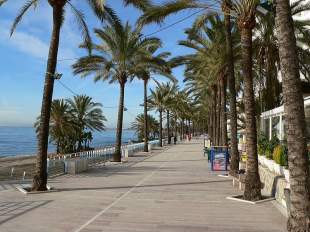 View of Marbella and the beach
Photo: © Manuel González Olaechea y Franco
Puerto Banús
Puerto Banús is a marina located in the area of Nueva Andalucía, to the southwest of Marbella. It was built in May 1970 by José Banús, a local property developer, as a luxury marina and shopping complex for the rich and famous. It has since became one of the largest entertainment centres in the Costa del Sol, and one of the favourite resorts of international celebrities, with 5 million annual visitors. Developed around a coastal village in the Mediterranean architectural style, Puerto Banús offers its visitors an extraordinary fare of expensive shopping malls, restaurants and bars with a marina studded with luxury yachts of the rich and famous with the interior streets having impressive archways and patios. Behind the harbour lie streets filled with bars, boutiques and nightclubs. There is beach on each side of the marina. Boats can also be hired here. Many of the yachts moored within can enjoy an unobstructed view of La Concha mountain, one of the coast's landmarks. Visitors may also want to see a three-ton statue of a rhinoceros by Salvador Dalí which was placed in Puerto Banús in 2004. Officially known as Rinoceronte vestido con puntillas ("Rhinoceros dressed in lace")
 Puerto Banús, Marbella
Photo: Lolo
Marbella is full of history with a little part of it to be found in every corner of the "old town", with its Moorish castle, and famous "Orange Square". The historical old quarter is full of narrow streets and flower filled balconies. The old town is partially surrounded by the ruins of an old Arab wall. At the heart of old town is Orange Square which dates back to 1485. It is surrounded by three historical buildings - the town hall, the old governor's house and the Chapel (Hermitage) of Santiago. At the end of Nueva Street stands a fountain which dates back to 1504. To the left of the fountain is the Old Governor's House which dates back to 1552. The town hall which was built on the square was erected in 1568. The Church of Saint Mary can also be found in the square. The beautiful facade and red stone entrance was built in Baroque style whilst the intetior underwent restoration after the Civil War. Also notably, the church contains a very special organ made up of 5000 pewter, copper and wooden pipes, four manual keyboards of 56 notes and a 36 note pedal.
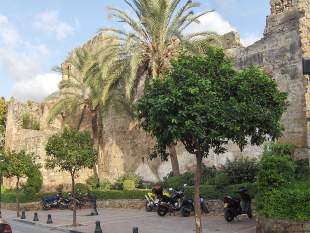
Medieval defensive walls of Marbella
Photo: Té y kriptonitaThe Bonsai Museum
The Bonsai Museum in Marbella is a fascinating place for the whole family to visit. It houses some 300 bonsai trees from 40 different species some of which are over 500 years. On exhibition is a magnificent display of trees and forests charmingly exhibited with a central water display with bonsai trees and sculptured rocks brought from the Torcal in Antequera. It is deservedly considered one of the best collections in Europe and also the best wild olive tree collection in the world. Other specimens which are of particular interest include the "Acebuche Olive" which is 300 years old and the Chinese "Almez" which belonged to the same Chinese familiy for five generations. There is an entrance fee of three euros. The museum is housed in a well designed modern building within Marbella's Arroyo de la Repressa Park.
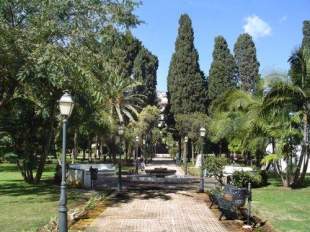 Parque de la RepresaParque de la Represa
Situated in the centre of Marbella, the Parque de la Represa is considered amongst the green spaces in this famous Costa del Sol resort town. Both for locals and tourists, this is a preferred leisure spot amid great facilities and services. With an area of two kilometres long and half a kilometre wide, this spacious park has artificial lakes, sports areas, benches, pathways, and shade areas for visitors to have a great time in a serene atmosphere. The park boasts two full-size football pitches, athletic tracks in addition to extensive green areas that together add to the beauty of the park. You will find the surrounding of the artificial lake really relaxing while taking a walk or seating on those wooden benches.
Golf
If you love golf then Marbella has spectacular golf courses that have been designed by the likes of Seve Ballesteros, Peter Alliss and Clive Clark. There are more than 40 quality courses to be played throughout the Costa del Sol making it a perfect destination for the golf enthusiast. Spain is the major golf destination on the European mainland. Until 2018, when France will host the Ryder Cup, it will remain the only country in continental Europe, as well as the only non-English-speaking country, to have hosted that event.
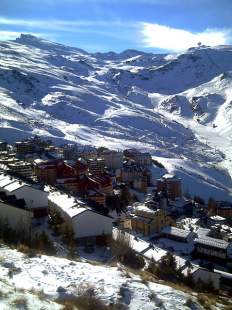 Pradollano resort in Sierra Nevada, Spain
Photo: Javier Martin
Marbella is the perfect place from which to visit the famous Spanish Ski resort of Sierra Nevada which is only an hour away by car. The Sierra Nevada (meaning "snowy range" in Spanish) contains the country's tallest mountains, rising to over 10,000 ft (3000+ metres). The highest peak is Mulhacén at 3,479 m. These high peaks make skiing possible in one of Europe's most southerly ski resorts, in an area along the Mediterranean Sea predominantly known for its warm temperatures and abundant sunshine.
Roman Baths
Located next to the beach in the Guadalmina urbanisation, the baths date back to the 3rd century and were first discovered in 1926. Archaeological digs have found human habitation from Paleolithic and Neolithic times. There are Phoenician and Carthaginian remains and in Roman times Marbella was called Salduba. The name derives from the Arab 'Marbil-la', from the Islamic era of southern Spain, with the town only being reconquered by the Spaniards in 1485. General held conclusions about the crypts were that they were Roman Baths, although some believe that they were large deposits for the water carried by the nearby aqueducts. The keys to visit these ruins can be obtained from the San Pedro de Alcantera tourist office. Opening hours are Tuesdays, Thursdays and Saturdays at 12 am.
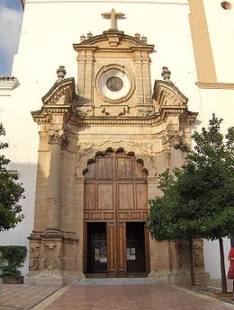 Iglesia de la Encarnación, Marbella
Photo: Tyk
The Iglesia de la Encarnación is a religious shrine under the patronage of St. Mary. The church has four towers, each 50m in height topped by a pyramidal spire. The church dates back to the 16th and 17th century.
Spanish Contemporary Engraving Museum
The Museo del Grabado Español Contemporáneo is located in the old Hospital Bazan in Marbella just behind the Church of St. Mary of the Incarnation. It houses exhibitions of engravings and art works by national artists as well as courses in engraving, conferences on art, concerts and drawing competitions. The Museum also organises the National Engraving Awards every year. It showcases a complete panorama of the best of contemporary Spanish art captured in a medium that has become widely accepted by modern-day artists and including etchings, aquatints, lithographs, xylographs and other forms of graphic expression used by artists of international renown such as Picasso, Tápies and Miró. Guided tours are available by appointment.
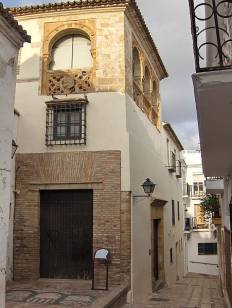 Hospital Bazán, home of
the Museum of Contemporary Spanish Engravings
|
|
|
Festivals & Events
Seville Fair
The Feria de abril de Sevilla, literally Seville April Fair, is held
in the Andalusian capital of Seville, Spain. The fair generally begins
two weeks after the Semana Santa, or Easter Holy Week. The fair
officially begins at midnight on Monday, and runs six days, ending on
the following Sunday. Each day the fiesta begins with the parade of
carriages and riders, at midday, carrying Seville's leading citizens
which make their way to the bullring, La Real Maestranza, where the
bullfighters and breeders meet.
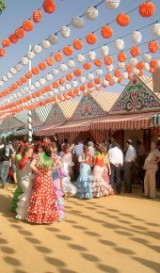 Casetas at Seville Fair
Photo: EdTarwinski
San Fermín
The festival of San Fermín is renowned for it's celebratory
tradition and is held in Pamplona anually on the 6th July. It is known
locally as Sanfermines and is held in honour of Saint Fermin. This
festival is important in terms of Spanish folklore and tradition. The
week long fiesta is most famous for it's encierro (running of the
bulls). It is belived that a million people flock to see this event
every year. The opening of the fiesta is marked by setting off the
pyrotechnic chupinazo. The rocket is launched at 12:00 noon on the 6th
of July from a city hall balcony with thousands of people celebrating
the act in the city hall square and other locations in Pamplona.
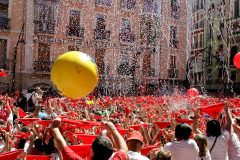 San Fermín Festival seen from
the Town Hall in Pamplona
Photo: Viajar24h
Fiestas del Pilar
Fiestas del Pilar is a large festival that takes place in Zaragoza,
Spain. This festival is religiously rooted in Spain and based on the
belief that Virgin Mary appeared to Saint James standing on a pillar.
The celebration lasts for seven days during which the city is bustling
with energy as over two million people visit the city for this fiesta.
Every day at 8 o'clock in the morning there is an event called
vaquillas, that is amateur bullfighting in the towns bullfighting ring,
or Plaza de toros. Everyone who is brave enough, can participate in this
event, in which many people get injured every year. The most important
celebration takes place on the 12th October, "The offering of flowers"
to the Virgin, who is removed from the Basilica and exhibited in a
platform placed on the square where the temple lies. The Offering of
Flowers is one of the more famous festive symbols of Spain.
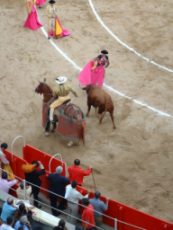 San Fermín Festival seen from
Bull running in Barcelona
Photo: BPG
Carnival
Carnival is a festive season which occurs immediately before Lent;
the main events are usually during February. Carnival typically involves
a public celebration or parade combining some elements of a circus,
mask and public street party. The Santa Cruz de Tenerifeand Las Palmas
de Gran Canaria is together with the Carnival of Cadiz, the most
important festival for Spanish tourism and Spain's largest carnival. In
Catalonia people dress up and organise parties for a week but
particularly on the weekend. Despite it being winter, parties are open
air, beginning with a cercavila to call everybody to come. Rues of
people dance along the streets. On Thursday Dijous Gras is celebrated,
also called 'the omelette day' and omelettes are eaten. Parties end by
burning Mr. Carnestoltes and with enterrament de la sardina (sardine's
funeral). Carnaval de Solsona takes place in Solsona, Lleida in central
Catalonia. It is one of the longest carnivals in Catalonia; free events
in the streets, and concerts every night, run for more than a week.
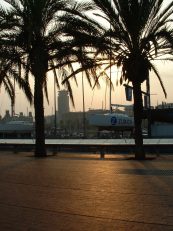 Barcelona harbour
Photo: BPG
Festival Internacional de Benicàssim
The Festival Internacional de Benicàssim is an annual music festival
sponsored by a well known beer label which takes place in the village of
Benicàssim, province of Castelló, Valencian Community in Spain. It
focuses mainly on pop, rock and electronica artists, as well as having
other elements besides music like short films, theatre, fashion and art.
Since the first festival in 1995, some of the most notable artists who
have played the festival include Paul Weller, Depeche Mode, Beck,
Radiohead, Kraftwerk, The Stone Roses, Brian Wilson, Blur, Lou Reed,
Oasis, The Chemical Brothers, Franz Ferdinand, The Killers, Morrissey,
Sigur Rós, Ride and The Strokes. As of 28 January, the line up for the
2011 Festival is as follows: Arcade Fire, Arctic Monkeys, Mumford &
Sons, Portishead, The Strokes, Beirut, Catpeople, Elbow, Friendly Fires,
Julieta Venegas, Lori Meyers, Primal Scream (present Screamadelica),
The Streets, Tinie Tempah, The Coronas, Grupo Salvaje, The Marzipan Man
Smile, Veronica Falls, Paolo Nutini, Pendulum, Mahmiri Acar. 'FIB' is
held in the seaside resort of Benicassim (Castellón province) on Costa
del Azahar, Valencia, Spain, 92.2 km away from Valencia Airport.
Festival goers who have purchased multi-day passes can camp for up to 9
days starting Monday before the festival starts and ending Tuesday after
the festival has ended. For more information please contact info@fiberfib.com
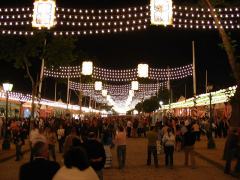
Festimad
Festimad is an alternative rock festival and cultural event held yearly
in Madrid, Spain since 1994, usually in the last week of May. Festimad
includes several parallel cultural festivals such as Performa, Graffiti,
Universimad o Cinemad, although its central event continues to be the
music festival, standing alongside the Festival Internacional de
Benicàssim as Spain's main rock concert. For more information please
contact festimad@festimad.es
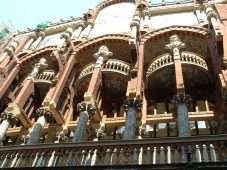 Photo: BPG
Bilbao Live Festival
The Bilbao Live Festival is a rock and pop music festival that takes
place in the summer in Bilbao, Spain since 2006. It is supported by BBK
the savings bank. Some 51,000 people attended the first edition of
Bilbao Live Festival in 2006, an event that reunited during three days
more than 40 national and international bands of rock and carps of
electronic music. Bilbao had thus burst in with force into the circuit
of great musical festivals of the summer time. The 2011 lineup includes
Coldplay, Blondie, Beady Eye, Crystal Castles, Russian Red, Ken Zazpi,
Amy Winehouse, Kasabian, Kaiser Chiefs, The Black Crowes, The Chemical
Brothers, Jack Johnson, 30 Seconds to Mars, M-Clan. For more information
please contact festivals@nme.com
|